"Traveler, there is no path, the path is made by walking"
-Antonio Machado
Putting Carmel's business district on this list may seem too obvious, but you need to look around here for secret passageways. Some just lead to where people keep their garbage, but many lead to other parts of town, or to hidden shops and galleries.
Some people say this village is boring for kids, but we've found that youngsters of all ages love to explore the town's magical nooks and crannies which feel like real-life versions of the mythical Diagon Alley in the Harry Potter stories.
For guided walking tours of Carmel, we recommend Carmel Walks. You'll get to know the fascinating stories behind the town's unique and quirky architecture.
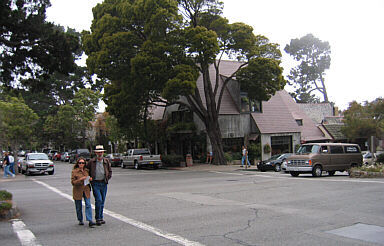
Carmel Point can be found just outside the southwest corner of Carmel's city limit. Its rugged shoreline separates Carmel city beach from Carmel River State Beach. If you only have time for one easy walk, this is where you should go. Some of the Monterey Peninsula's most dramatic scenery, from Pebble Beach to Point Lobos, can be surveyed from this one small meeting of land and sea. It is so stunningly spectacular in any weather that you may be surprised to find the locals out soaking it in during a winter storm!
Walk along Scenic Road which follows the shoreline. You can also drive it (one-way southbound only) if you prefer, but you'll miss a lot of details. There are no sidewalks, so watch for cars and try not to block their way. As you take in the sights, the sounds, and sea the smell air, don't forget to notice the local architecture. There are a number of famous houses out here with fascinating stories behind their walls.
On the point's north side, marking the south end of Carmel city beach, is a house designed by Frank Lloyd Wright known as the Walker House. Its copper roof and Carmel Stone prow looks like a ship emerging from the rocks heading out into Carmel Bay. Look across the bay and you'll spot the Lodge at Pebble Beach behind the emerald carpet of the famous golf course.
Just around the bend take a peek up Ocean View Ave into a tunnel of trees. You'll spy a white stone house which seems as if it is always in the sunshine, even on the foggiest of days. Glance to the left side of Ocean View and you'll see an even bigger stone house. It was built by Ted Kuster, founder of Carmel's Golden Bough Theater. He built it in a failed effort to lure back his wife Una, who had run off with the famous poet Robinson Jeffers.
Jeffers, you see, had earlier built a magnificent stone house, known as Tor House, just one block south. You'll see it and the adjacent Hawk Tower, which Jeffers built as a retreat for Una, just before you get to Stewarts Way. And while you're here, notice the canopy of Monterey Cypress trees that blankets the neighborhood. Jeffers planted most of 'em. Before he came here Carmel Point was a meadow!
Next, turning back to the ocean side of the street you'll see the 1950s era "Butterfly House" so named for its inverted roof. Finally, at the southwest corner of Carmel Point, at the sharp turn, behind a nondescript wooden fence, lies the former home of the Hollywood actress Jean Arthur (Clarissa in Mr. Smith Goes to Washington), where she lived for several decades until her passing in 1991. From this corner you will no doubt notice a spectacular panoramic view stretching from Carmel Valley out to Point Lobos.
Of course, we're assuming that you're walking southbound. Should you decide to walk northbound you'll need to read the previous paragraphs backwards. Anyway, once you've made it from one beach to the other, you can either double back along the shore, or take a shortcut through the neighborhood. Maybe you can spot the Inspiration Avenue home of the late General Joseph "Vinegar Joe" Stillwell, commander of the China India Burma Theater during WWII. If you can't find it don't feel bad. Mr. Toy hasn't figured out which house it is, either!
To learn about Carmel Point's adjacent beaches, see The Monterey Peninsula's Best Beaches.
Mission Trail Park is a small canyon that runs from a point just east of downtown Carmel to the Carmel Mission. Few people know it is there. To find it go to the intersection of Ocean Avenue and Junipero. Look for Mountain View Avenue, the street that goes up diagonally from the intersection. Take it a few blocks to the end. The park begins there with a footbridge. The southern entrance to the park is on Rio Road across from the Carmel Mission. There is another well-hidden entrance half-way between, but you'll never find it without being taken by the hand, so we won't bother giving directions.
A wide, well maintained path connects the park's endpoints. A similar path to the west parallels the main path in the southern areas of the park. A network of more rugged footpaths runs along the eastern side. These will take you up towards the old Flanders Mansion and to the adjacent arboretum. Some of these trails offer views of the Carmel Mission and Carmel Bay beyond. Here in the forest it is not uncommon to see (or at least hear) redheaded woodpeckers practicing their craft.
The only drawback is that there is virtually no parking at either end of the park, so you'll have to walk a bit just to get there. Moreover, Rio Road is difficult to cross safely, so be cautious.
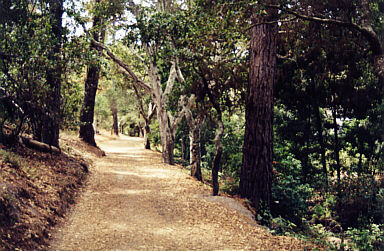
Hatton Canyon runs parallel to Highway 1 behind the Carmel High School. For over 40 years it was threatened by Caltrans whose engineers wanted to fill it in and build a freeway bypass. During the summer of 2001 Governor Gray Davis signed bill to turn the land over to California State Parks, ending a bitter and divisive controversy.
Hatton Canyon contains a rich diversity of habitats over its two-mile length. The upper region is a steep V-shaped gorge in a dense Monterey Pine forest. A little farther down, the east hillside of the canyon opens up into a broad grassland. The middle of the canyon features a fair sized meadow, bordered on the north by a grove of oaks. Farther down is a lush Monterey Pine forest with a perennial stream. As it approaches Carmel Valley, there are cottonwoods and a thick grove of willows concealing a bulrush marsh.
This is a great area for birdwatching. At various times Mr. Toy has spotted hawks, owls, quail, woodpeckers, and many others too numerous to mention. You might also encounter deer and other woodland creatures.
If Caltrans had its way, everything along the main trail would have been buried 25-60 feet below the roadway. The hillsides in the upper canyon, in clear view of the existing highway, were to be carved beyond recognition. We can now rest assured that this diverse ecosystem will be preserved for all time.
The lower two-thirds of the canyon are easily accessible. To get to the middle areas of the canyon go to Carmel High School, at Ocean Avenue and Highway 1. From the school parking lot drive one block north along the frontage road parallel to the highway. Turn right onto Flanders Drive. Follow it down and around to the first street that turns off to the left, Canyon Drive. Take the short road that goes down to the left, not the one that goes up to the right. Begin your walk at the gate.
Another way to enter the canyon is from the mouth of Carmel Valley. Park at one of the shopping centers closest to the highway and make your way to the path that runs between The Barnyard and Highway 1. A pedestrian tunnel will take you under Carmel Valley Road and once you're through that you're in Hatton Canyon. The largest wetlands in the canyon are just a few steps beyond this entrance.
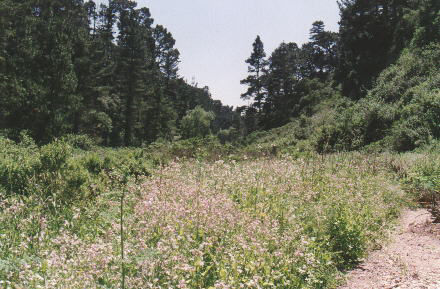
Located just a few miles south of Carmel on Highway 1, Point Lobos is loaded with trails and picnic areas. They're all pretty, but the most spectacular trails are the North Shore Trail, and the Cypress Grove Trail. China Cove, located just past the last parking lot, is another favorite spot. The park is fairly compact, so you can cover a good portion of it in a couple of hours.
Parking is limited, however, and so is the number of cars allowed in the park at any one time. During busy times there may be a waiting line to get in, so early birds tend to have the best luck. There is an admission fee. Mr. Toy is not sure what it is this week, but the Point Lobos Foundation will tell you. They'll also fill you in on park rules which are stricter than average.
Point Lobos was a favorite hangout for pioneering photographers like Edward Weston and Ansel Adams who, as you know, had good taste.
Hang this on your wall as a daily reminder of your visit to Point Lobos. Get something beautiful for your home or office knowing your purchase helps support this website and the man behind it.
Soberanes Point is part of Garrapata State Park along Highway 1 just a few miles south of Point Lobos. Look for a dramatic ridgeline that plunges into the sea. That's Soberanes Point. There are easy trails around the edge of the point. If you don't mind a little climbing you can gain some elevation at the top of Whale Peak for some great photo ops. The best part is it's all free. Sort of a poor man's Point Lobos.
For more Big Sur hiking adventures, the Big Sur Chamber of Commerce has a great guide to hiking trails in the area.
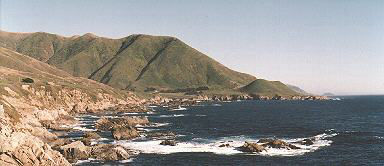
Garland Park, as most folks call it, is located about eight miles east of Highway 1 on Carmel Valley Road. If wide-open acreage is what you like, this is the place to go. This park is over four miles long and roughly two miles wide.
Park your car in the spacious lot alongside Carmel Valley Road. A footbridge over the Carmel River will take you into the park. After crossing the bridge turn left and check out the visitors center for maps and other important info. Then its time to explore. There are some easy trails along the flood plain, and trails ranging from moderate to very steep in the hills. Hardy hikers can make a full day of it and walk to the ridgeline which reaches an elevation of almost 2,000 feet! Caution: on hot days or long hikes be sure to carry water with you.
Garland Park has no admission fee. Hooray!
Way up high in the Monterey Pines is Jacks Peak. It was named after former mega-landowner David Jacks, who invented Monterey Jack cheese. The park straddles the ridgeline between Monterey and Carmel Valley. Two words sum it up: panoramic views. Trails range from moderate to pretty hard. For first-time visitors, there's a self-guided nature trail that has all the best views on a relatively short loop.
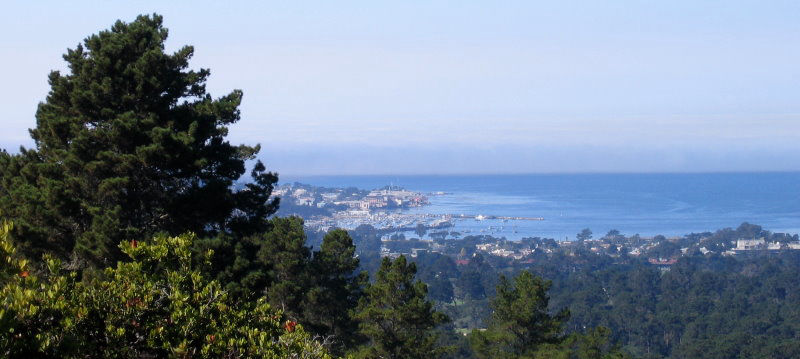
To get there take Highway 68 from Monterey east towards Salinas. Go to Olmsted Road, which is across from the entrance to the Monterey airport. Turn right on Olmsted. Go to Jacks Peak Drive and turn left. When you pass the guard house turn right and go to the parking lot at the end of the road. The self guided nature trail is right off of the parking lot. They've got pretty decent rest rooms here, too.
Jacks Peak used to charge an admission fee, but the county decided to make it free in 2021. We expect they may charge admission again someday if the budget gets tight, so we advise you to be prepared just in case.
The Shoreline Recreation Trail is a combo bike/pedestrian path that extends along the northern shoreline of the Peninsula. The segment you'll most likely use begins at Fisherman's Wharf in Monterey and runs more or less northwest two miles out to Lovers Point in Pacific Grove. It follows a former railroad right-of-way past Monterey Harbor, through Cannery Row (where you'll pass a few historic railroad artifacts), past the aquarium, and alongside Pacific Grove's beautifully rugged shoreline. The Pacific Grove portion separates bicyclists from walkers. Bicycles use the paved surface, while walkers take the earthen path, which takes you closer to the water.
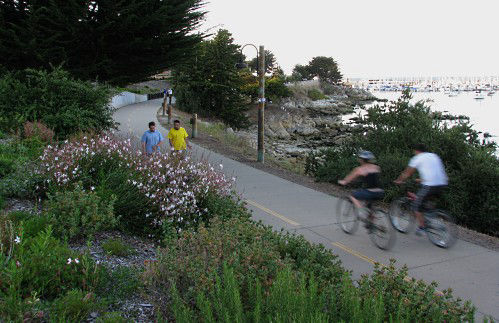
Take your binoculars. The segments that run between the wharf and Cannery Row, and between the aquarium and Lover's Point are great places to watch sea otters, seals, and sea lions. The latter two are relatively easy to spot because of their size, but when they're on a rock basking in the sun they can look like part of the rock, so look closely.
Otters, on the other hand, are often hiding in plain sight. It's possible to find them in open water, but if you don't see anything, look again. Otters dive a lot, so one minute they're there, the next they're not, until they are again. You may also find them in kelp beds where they're often mistaken for kelp floats (and vice-versa). Using your ears as well as your eyes can help you find them. Listen for a tapping sound as they beat shellfish against rocks on their stomachs to open the shells. If you hear faint, high-pitched squeals that indicates that a mother and baby are nearby. The youngsters tend to cry when mom goes diving.
SAFETY TIPS:
Treat the rec trail like a road. It has a dashed yellow line down the middle to make it easy. Since it is used by both bikers and pedestrians, you must look both ways before crossing it, or you may step into the path of a bike. Likewise, whether pedaling or walking you should look over your shoulder before you change lanes. As noted above there are separate paths for bicyclists and pedestrians in the Pacific Grove segment between the aquarium and Lovers Point. It's a good idea to know which is which (bikes on the pavement, shoes on the earthen surface).
Downtown Monterey is loaded with historic buildings, probably due to the fact that it is the second oldest city on the west coast and was the center of California's government before it was a state. There's a self-guided tour you can take to see these sites, called the Path of History. Google doesn't make a map of this but you can download a brochure with a map here.
Among the highlights is Colton Hall, which locals affectionately (though somewhat erroneously) say was California's first capitol building. The state constitution was written and ratified there in 1850. Another treasure is the San Carlos Cathedral (a.k.a. the Royal Presidio Chapel) which is California's oldest church, having been in continuous operation since it was built in 1794. The Cooper-Molera Adobe, located where Munras Avenue becomes Alvarado Street, has a lovely hidden garden. At the other end of Alvarado, at the Custom House Plaza near Fisherman's Wharf, you'll find the old Custom House and Pacific House, the latter having another hidden garden. Immediately west of Fisherman's Wharf, tucked into an office complex called Heritage Harbor, you'll find yet another garden behind the Old Whaling Station and the city's First Brick House. In case you didn't notice, Mr. Toy loves hidden gardens.
The brochure showing the route can be found in most hotel lobbies and at the historic sites operated by the state parks people. If you can't wait, just download it now. Or you can just follow the yellow ceramic dots in the sidewalk and fake your way along. You can easily identify a historic site. There'll be a sign out front that's shaped like a loaf of bread with a hat. When you see that you'll know you're at a Genuine Historic Building.
For an in-depth guided tour of Monterey's historic sites, sign up with Monterey Walking Tours.
HTML Maker